
News
Global trends revealed at GPD
Knowledge grows when knowledge is shared.
July 31, 2018 By Jorma Vitkala
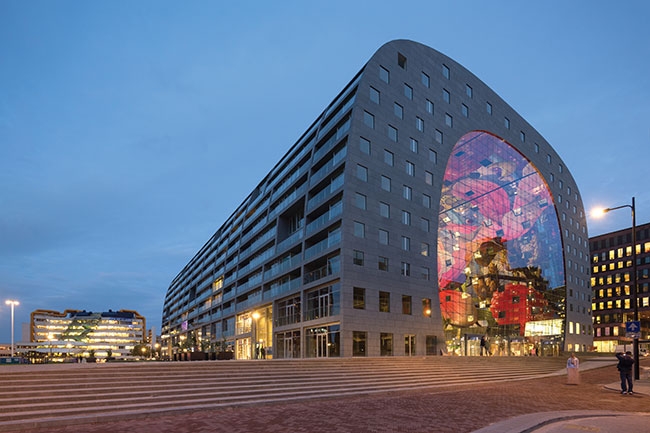 The Market Hall in Rotterdam, Netherlands, features the largest suspended cable facade in Europe. The building combines residential living with an open shopping area in the middle.
The Market Hall in Rotterdam, Netherlands, features the largest suspended cable facade in Europe. The building combines residential living with an open shopping area in the middle. It’s a time of real advancement in the technology of glazed building facades. Thanks to innovations in computer and materials science, our projects can be bigger, higher-performing and more beautiful than ever before
Glass Performance Days (GPD) is a leading glass industry conference taking place each year in Tampere, Finland. The philosophy of GPD is summed up with a quotation from the Indian poet, Bhartrihar: knowledge grows when knowledge is shared. The purpose of the event is to develop the whole glass supply chain globally.
At the 25th anniversary GPD event, experts in the field held 180 presentations on new technologies, trends and innovations. The following is a summary of more than 10,000 PowerPoint slides, boiled down to the most interesting and most important topics.
Worldwide glass market trends
The glass industry has experienced significant changes over the past 25 years. New players have entered the market and production has grown. Twenty-five years ago there were 150 float lines, now there are more than 500. Just a quarter of a century ago Europe, the United States and Japan produced 60 per cent of all the glass in the world. Now their share has dropped to below 20 per cent.
The rise of eastern Asia, especially China, is reflected in the market in many ways. In Asia, demand and manufacturing are both on the rise. More than half of all float lines and production capacity are located in China and there are more than 7,000 Chinese glass patents nowadays – a significant growth from the slightly more than 300 patents there were 25 years ago.
The production capacity of float lines and the life cycle of furnaces have increased. There have been technical developments in efficient energy use, melting technology and various coating technologies. The thin glass developed for cellular phones and tablets is used more and more in architecture, interior design and the automotive industry.
Fabrication processes have also improved significantly in 25 years. The size of safety glass and insulating glass elements has increased considerably and the new coatings raise energy efficiency to a whole new level. Energy balance is given special attention today. Glass can be bent into more complex shapes and different coatings give it new features and possibilities. Process automation has increased and improved production efficiency. Better quality control, on the other hand, has reduced the number of complaints and errors in the various stages of the fabrication process.
The total demand for flat glass in 2016 was 73 million tons, or 9.2 billion square metres (calculated on three-millimeter glass) dominated by China (51 per cent of global demand). The growth in demand is very fast in China because of the current construction boom. There are also a great number of buildings with single-glazed windows about to be renovated in China and in Central Europe as well. In Europe, triple glazing is becoming a new standard. In energy-efficient modern construction, all this means an increased use of coated insulating glass elements.
The development of new technologies and products has remained mostly in Europe and in the U.S. Automotive and automotive glass industries are also focusing on Asia, but in this area, too, R&D and design is often carried out in Europe.
Glass is used above all for architectural purposes (facades, interiors and refurbishment). Building glass accounts for about 80 per cent of total flat glass demand. The automotive industry uses 10 per cent of total glass demand and the remaining 10 per cent go to different special applications, such as fast-growing solar glass applications.
It is worth noting the growing amount of buildings 200 metres tall or taller. The construction of high-rise buildings has increased rapidly as a result of sharp rises in urbanization and land plot prices. Climate consciousness also favours high buildings as close construction reduces carbon dioxide emissions from traffic. In 2017, there were already over 1,300 buildings in the world that rise over 200 metres.
Industry 4.0 and the internet of things
Industry 4.0 is a concept of a fourth industrial revolution first coined in Germany. IoT (Internet of Things, the industrial internet) is changing production and operating methods significantly. Automation and digitalization bring productivity to a new level in efficiency, flexibility, quality and time-to-market.
Glaston and other players have developed the collecting and processing of big data as it opens up a whole new kind of potential. For example, the properties of every single piece of glass can be traced over the decades. In buildings, databases used for building materials will track their properties and recyclability to greatly improve security of supply.
Worldwide glass design trends
No matter if it is a city-centre skyscraper or a small town house on the design board, the natural surroundings and nearby buildings are carefully taken into consideration by the architect. How the building fits into its environment; the angle of the sun; where the wind comes from; the effect of the local climate on the energy consumption of the building…all these and more are now part of how architects approach their projects.
One of the biggest trends is total transparency, where glass is the most natural choice. Transparent glass connects the building with its surroundings, nature and people. On the other hand, it separates and protects against natural forces. In advanced glass technology, the transparency of the glass can be dynamically adjusted, which offers new opportunities for glass interior decoration and for managing energy flows in the facade of a building.
Large, uniform glass surfaces are nowadays energy-efficient and able to keep heat either indoors or outdoors, whichever is required. In tall buildings, facades can be converted into attractions. For example, in Hong Kong, skyscrapers are used as platforms on which computer-controlled LEDs illuminate impressive animated images. In the future this will be utilized in many ways in entertainment and communication. A glass-bottomed bridge over a canyon is a major attraction and a sure “Wow!” effect, at the same time offering safe passage to the other side of the canyon.
Fondation Louis Vuitton in Paris, designed by Frank Gehry, is an excellent example of the diversity of glass in construction. The trend is to use unconventional, softer or more organic forms in the buildings. This has raised the demand for bent glass. As bending technologies have also developed, the multifunctional use of glass can add shape, spectacle and distinctiveness to any building.
Daylighting
There is a lot of research data on the effects of daylight. For example, it improves work performance and learning achievements and makes patients recover faster. Daylight utilization is therefore justified in the design of buildings by wellbeing, profitability and sustainability.
By using glass, daylight can be brought into the building and reflected further in the interior. Transparent structures in the interior can allow light to pass deeper into the building and be re-directed with reflecting surfaces.
To get the best of daylight and energy balance, we can add movable sunshades, switchable glazings, solar panels and – the latest development – transparent solar panels that are integrated into windows. There are already a lot of ways to utilize daylight for the comfort and wellbeing of inhabitants as well as for the energy production in the building while creating things that please the eye.
Worldwide automotive design trends
The development of glass technology will bring new trends to the automotive industry, especially to commercial vehicles. Glass is an important part of a vehicle’s the load-bearing structure. Glass sizes and shapes become more challenging for manufacturers, but at the same time they bring new experiences and applications to vehicle users. Commercial and passenger vehicle displays improve when display data can be projected on a windshield or shown on an in-built transparent display. The driver no longer has to take his or her eyes off the road or work area as the required information is displayed on the windshield.
In addition to safety, the automotive industry emphasizes energy efficiency. The need for cooling or heating can be reduced by using coated glass or smart glass to help regulate the vehicle’s interior temperature.
New technologies
Thin glass is already in use in mobile phones and tablets and it is coming into the construction and the automotive industries. Ultra-thin glass (0.01 to 0.3 millimetres) is so thin it can be rolled. There are already successful cases of the first roll-to-roll coated glasses, although they are still too narrow for architectural use.
Thin glass applications will be greatly diversified as manufacturing, coating and lamination technologies are improving. It will soon be possible to produce the wider sizes required by architecture and coating technologies will allow many new properties for mass-produced glass. There will be things like furniture laminated with ultra-thin glass or wallpaper made of it. And they will be durable and easy to clean in the same way as cell phones and tablets already are.
In architectural use, structural features can be added to glass in many ways, most typically by laminating tempered glasses with special films, by bonding a honeycomb structure inside insulating glass or by laminating a wire into a glass beam. Good design and glass bending will offer additional features. 3D printing has also taken its first steps in the glass industry, but so far it has had few applications.
Igloos made of electrically heated glass
Electrically heated glass has brought some good financial results to developers, for example, in the accommodation industry. Accommodation customers are willing to pay for unique experiences such as staying in a transparent igloo under the starry sky in the glow of the Northern Lights. There is no draft in the proximity of electrically heated glass to spoil the customers’ experience. Finnglass, one of the pioneers in the field, has been developing electrically heated glass for 20 years now and it would be suitable for many applications in modern construction. A heated glass wall is more expensive than traditional glazing but it generates substantial savings in energy consumption and increases available floor space. The inner surface of electrically heated glass is warmed one or two degrees above the room temperature, hence the cold wall effect and convection are prevented. The energy consumption is only 20-40 watts per square. Radiators or fans are not required, so the interior space is free for other uses. This brings significant benefits to space use and increases the building’s area. Electrically heated glass can also be used in glass ceilings to melt snow and ice and to prevent condensation.
Worldwide glass energy trends
Buildings account for 44 per cent of total energy consumption in EU countries (industrial buildings: seven per cent; domestic and tertiary buildings: 37 per cent). Switching to more energy-efficient windows would allow significant savings as windows are estimated to be responsible for 24 per cent of heating needs in the EU and for nine per cent of cooling needs.
The impact of buildings on energy consumption is enormous: they use 60 per cent of all electricity produced and account for more than one-third of greenhouse gas emissions.
It is not just about how windows keep the heat inside (reducing the need for heating) or outside (the need for cooling decreases). An intelligent facade can convert sunshine into energy. Integrated solar panels are also becoming popular in Finland and the Nordic countries. Transparent solar panels are integrated into windows and the user does not notice the difference compared to a traditional window. With regard to solar collectors, new ideas on how to produce warm air and hot water or to apply them to cooling the building are already in use.
In today’s digital printing processes a resolution up to 1,400 dots per inch is achieved and it is possible to decorate large surfaces, like different views on the outside and inside walls of a building. At the same time, the energy balance of the building can be improved with ceramic ink that absorbs excess energy.
The building of the future produces at least part of the energy it uses and automatically balances its energy streams. Its windows can regulate the amount of heat and light passing through them and also use infrared and ultraviolet components of light to produce electricity. Smart glass and media facade technologies are being developed, so interesting news is on the horizon.
Structural glass applications
Tim Macfarlane was on of the first to start developing the use of glass as a structural material in buildings in the ‘70s and ‘80s. This has given rise to the idea of total transparency, where wind and structural loads can be borne with glass structures to create new types of buildings. Of course, this has put demands on glass machine manufacturers and glass processors for new products and equipment for handling and transferring large and heavy glass panels.
Cold bent glass has been used in buildings for over 10 years and, because the experiences are good, the use has increased and diversified. In cold bending the insulating glass element made of tempered flat glass is mechanically bent in the shape of the building frame when installed. However, the sharpest bends are always made by thermal bending. The latest and most demanding process is lamination bending, which is carried out in connection with the autoclave process. This method requires a lot of experience and know-how, but it will
diversify the possibilities in glass construction.
The latest addition is the introduction of transparent structural silicones. They enable design of even more transparent structures and applications.
Worldwide glass quality trends
Tempered glass sizes have grown considerably over the last couple of decades; today the largest glasses are 3.3 by 20 metres. Growth in glass sizes and new coatings create particularly strict demands for the tempering and lamination processes, so quality control and the various measurement methods are important.
Product development in Glaston and Viprotron has focused, among other things, on the development of anisotropy and/or roller wave distortion measurement methods. This enables better quality to be achieved to suit the most demanding applications. Sparklike has developed a method for measuring the argon gas content of insulating glass elements through the glass. This can be done either on the production line, after production at the factory or on the construction site. It ensures that elements not meeting the agreed values are not used in buildings. Measuring in these projects is always cheaper than replacing faulty elements after construction work.
About the author
Jorma Vitkala is the founder of the Glass Performance Days Conference (GPD) and has been chairing the organizing committee since the beginning. He is the first recipient of the “The Jorma Vitkala Award of Merit” awarded by the international glass industry by Dow Corning and Kuraray. At the same occasion, Vitkala received several recognitions: the special awards of the HKFA (Hong Kong Facade Association) and the KAFA (Korean Architect Façade Association), a USGlass plaque and a honourary membership in the Glass Association of North America. The Finnish Flat Glass Association has nominated Vitkala Glass Builder of the Year 2013 and he received the Tampere Congress Award in 2001.
Print this page
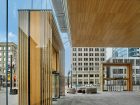
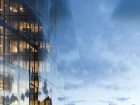
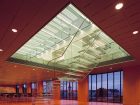
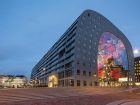
Leave a Reply